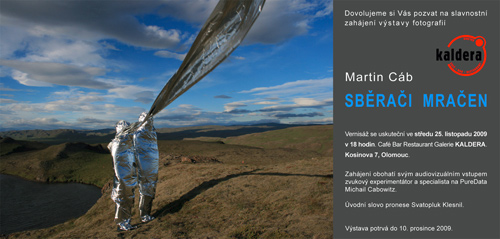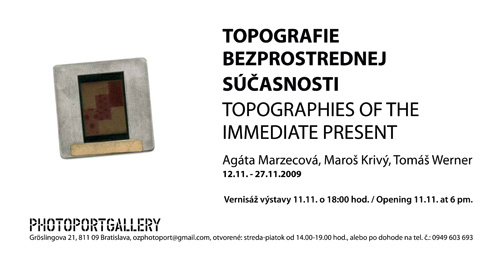Archiv
únor 2021
říjen 2020
září 2020
srpen 2020
leden 2020
prosinec 2019
červen 2019
prosinec 2018
září 2018
srpen 2018
květen 2018
duben 2018
březen 2018
prosinec 2017
listopad 2017
říjen 2017
září 2017
srpen 2017
červenec 2017
červen 2017
květen 2017
duben 2017
březen 2017
únor 2017
leden 2017
prosinec 2016
listopad 2016
říjen 2016
září 2016
srpen 2016
červen 2016
květen 2016
duben 2016
březen 2016
únor 2016
leden 2016
prosinec 2015
listopad 2015
říjen 2015
září 2015
srpen 2015
červenec 2015
červen 2015
květen 2015
duben 2015
březen 2015
únor 2015
leden 2015
prosinec 2014
listopad 2014
říjen 2014
září 2014
srpen 2014
červenec 2014
červen 2014
květen 2014
duben 2014
březen 2014
únor 2014
leden 2014
prosinec 2013
listopad 2013
říjen 2013
září 2013
srpen 2013
červenec 2013
červen 2013
květen 2013
duben 2013
březen 2013
únor 2013
leden 2013
prosinec 2012
listopad 2012
říjen 2012
září 2012
srpen 2012
červen 2012
květen 2012
duben 2012
březen 2012
únor 2012
leden 2012
prosinec 2011
listopad 2011
říjen 2011
září 2011
srpen 2011
červenec 2011
červen 2011
květen 2011
duben 2011
březen 2011
únor 2011
leden 2011
prosinec 2010
listopad 2010
říjen 2010
září 2010
srpen 2010
červenec 2010
červen 2010
květen 2010
duben 2010
březen 2010
únor 2010
leden 2010
prosinec 2009
listopad 2009
říjen 2009
září 2009
srpen 2009
červenec 2009
červen 2009
květen 2009
duben 2009
březen 2009
únor 2009
leden 2009
prosinec 2008
listopad 2008
říjen 2008
září 2008
srpen 2008
červenec 2008
červen 2008
květen 2008
duben 2008
březen 2008
únor 2008
leden 2008
prosinec 2007
listopad 2007
říjen 2007
září 2007
srpen 2007
červenec 2007
červen 2007
květen 2007
duben 2007
březen 2007
únor 2007
leden 2007
prosinec 2006
listopad 2006
říjen 2006
září 2006
srpen 2006
červenec 2006
červen 2006
květen 2006
duben 2006
březen 2006
únor 2006
leden 2006
prosinec 2005
listopad 2005
září 2005
červen 2005
květen 2005
duben 2005
březen 2005
únor 2005
leden 2005
prosinec 2004
listopad 2004
říjen 2004
září 2004
srpen 2004
červenec 2004
červen 2004
duben 2004
únor 2004
leden 2004
prosinec 2003
listopad 2003
říjen 2003
září 2003
srpen 2003
červenec 2003
červen 2003
květen 2003
duben 2003
březen 2003
únor 2003
leden 2003
prosinec 2002
listopad 2002
říjen 2002
září 2002
červenec 2002
červen 2002
30/11/2009
Nevěsty poté

25/11/2009
Studenti ITF získali ceny v soutěži Czech Press Photo 2009
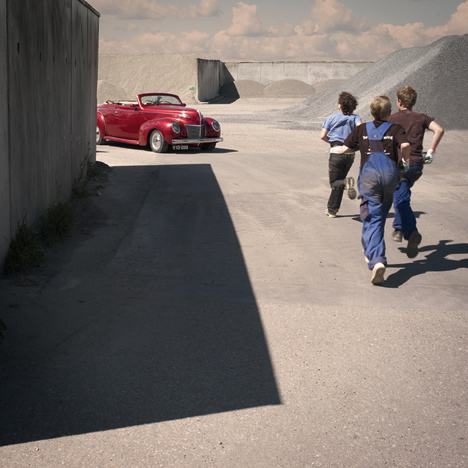
Do letošního ročníku soutěže Czech Press Photo se sešlo 4310 snímků od 281 fotografů. Mezi autory, kteří byli ocenění mezinárodní porotou a jejichž práce jsou až do konce ledna 2010 vystaveny na Staroměstské radnici v Praze, je opět řada současných studentů Institutu tvůrčí fotografie FPF Slezské univerzity:
Matěj Třešňák – 1. cena v kategorii Umění a zábava
Veronika Lukášová – 1. cena v kategorii Portrét
Roman Vondrouš – 2. cena v kategorii Lidé, o kterých se mluví a 2. cena v kategorii Umění a zábava
Svatopluk Klesnil – 2. cena v kategorii Každodenní život
Martin Wágner – 3. cena v kategorii Každodenní život
Několik dalších cen získali bývalí studenti ITF.
Sem vložte príslušný text vrátane HTML syntaxu alebo v prípade nevyužitia tejto časti všetko vymažte - teda vrátane tohoto textu!
23/11/2009
Výstava Barbory a Radima Žůrkových Zástupní v Bratislavě
 |
19. Měsíc fotografie, Galerie Artotéka, Kapucínská 1, Bratislava, 6. – 30. 11. 2009. Výstavu pořádá Institut tvůrčí fotografie FPF SU v Opavě, kurátor Vladimír Birgus.
Barbora a Radim Žůrkovi v poslední době rychle a intenzivně zazářili na české fotografické scéně. Dnes patří spolu Ditou Pepe, Barborou Kuklíkovou, Radqem Brousilem, Štěpánkou Stein se Salimem Issou, Kateřinou Držkovou, Janem Fauknerem, Barborou Bálkovou, Terezou Vlčkovou a dalšími k těm mladým českým fotografům, jimž se podařilo perfektně strefit do aktuálních tvůrčích tendencí a vytvořit koncepčně pevná, osobitá, vizuálně silná a technicky precizní díla, která oslovují široké publikum. Podobně jako většina z nich ani oni se nebojí fúzí „vysokého“ a „nízkého“ umění a hledání inspirací mimo ghetto tradiční fotografie ve filmu, hudbě, literatuře, výtvarném umění, ale také módě nebo reklamě. A také jako stále větší počet mladých autorů mistrovsky ovládají možnosti digitálních manipulací fotografického obrazu.. Místo tradičního zobrazování reálného světa a jeho obyvatel, které ve fotografii dominovalo po prvních sto padesát let její existence, vytvářejí obrazy neexistujícího světa a uměle vytvořených lidí, v nichž se stírají hranice mezi skutečností a fikcí. Fotografie dnes sice ztratila auru pravdivosti, která stejně nikdy plně neplatila, zato se stala téměř nelimitovaným prostředkem pro k zobrazování vizí nezávislých na konkrátních objektech.
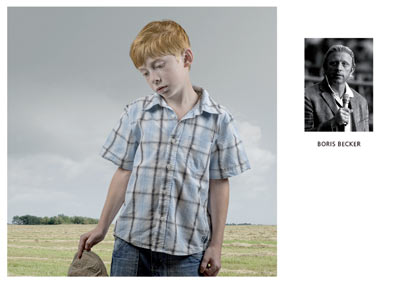 |
 |
K nejfrekvetovanějším tématům současné digitálně manipulované fotografie patří identita a typologie. Od dob, kdy Nancy Burson technicky nedokonale spojovala portréty různých diktátorů, filmových hereček nebo amerických prezidentů a z jejich průmětů vytvářela jakési zprůměrované typologické studie, pokročily digitální technologie daleko dopředu. Dnes poskytují možnost antropologům i umělcům vytvářet tobrazy “typických” francouzských žen, složené z tisíců různých portrétů a umožňují Yasamusovi Morimurovi, aby se sám začleňoval do obrazů starých i moderních mistrů stejně jako Tereze Vlčkové vytvářet přízračné portréty dvojic děvčat, u nichž si nejsme jisti, zda jde o skutečná dvojčata nebo jejich klony.
Motivy klonů a genetických vztahů intenzivně zajímají take Barboru a Radima Žůrkovy. Už v souboru Potomci/Descendants, jímž poprvé výrazně zaujali během svého společného studia na Institutu tvůrčí fotografie Slezské university v Opavě, vytvořili fiktivní děti autorky, chameleónsky měnící podobu, a různých mužů včetně jejího vlastního manžela. Komparativní trojice portrétů působí na první pohled jenom jako zábavná hra, v níž se ve tvářích neexistujících adolescentních dětí, vymodelovaných v počítači, spojují typické rysy obličejů obou údajných rodičů. Nejde však jenom o hru s geny, kdy se můžeme bavit srovnáváním podoby vygenerovaných mladých mužů a žen s podobami jejich údajných matek a otců. Hra je ostatně autory vědomě narušena tím, že věk dětí kolem dvaceti let je neadekvátní věku údajných rodičů, který je často jen nepatrně vyšší. Vždyť samotné Barboře Žůrkové, která v triptyších figuruje jako matka, jejíž rysy najdeme ve všech potomcích, je teprve dvaadvacet let (sami manželé Žůrkovi jsou zvědaví, nakolik jejich skutečná malá dcera bude jednou podobná teenagerce, kterou digitálně vytvořili). Autorům šlo o něco víc, jak sami napsali: “Pomocí počítačových montáží jsme se pokusili hledat obraz toho, kdo jsme, co jsme, co jsme byli a čím bychom mohli být.” Novou dimezi svému projektu dávají zavěšováním portrétů těchto neexistujících lidí na různé seznamovací servery.
Hlubší sociologický a psychologický podtext má i nejnovější cyklus manželů Žůrkových Zástupní/Replacement, který je nepochybně vyvrcholením jejich dosavadní tvorby, zahrnující i další práce (např. Cyklus expresivních portrétů slepců The Blind, oceněný v soutěži Czech Press Photo). V prázdných krajinách s nízkým horizontem a zamračenou oblohou zobrazili dívky a chlapce na prahu dospívání, kteří svými tvářemi (samozřejmě náležitě upravenými v počítači) připomínají dětské podoby či klony mnoha celebrit, všeobecně známých z televizních obrazovek nebo stránek novin a časopisů – herců Harrisona Forda, Al Pacina nebo Christophera Walkera, hereček Penélope Cruz, Joan Collins a Jessicy Lange, supermodelky Claudie Schiffer, fotbalistů Pelého a Pavla Nedvěda, zpěvačky Björk, “krále popu” Michaela Jacksona, tenisty Borise Beckera a dokonce i Wolfganga Amadea Mozarta. Na první pohled zaujme už obrazová a řemeslná kvalita samotných idylických portrétů dívkek a chlapců na rozhraní mezi dětstvím a dospíváním, mezi nevinností a dosud potlačovanou erotickou touhou. I když oblečení, účesy i digitálně zvýrazněna podoba těchto adolescentů nápadně připomínají sebevědomé slavné a bohaté osobnosti, z jejich andělsky krásných tváří přímo vyzařuje nejistota, zmatek a melancholie. To ještě umocňují smutné krajiny bez slunce a tlumené barvy.. Žůrkovi tak zdůrazňují napětí ve vztahu mezi originálem a jeho klonem. Nejsme si jisti, zda jde o dětské portréty celebrit, o jejich klony nebo o asdolescenty, kteří se snaží co nejvíce se přiblížit ke svým idolům (vzpomeňme, kolik jsme jich viděli během mediální smršti po smrti Michaela Jacksona). Autoři nás nechávají v nejistotě, ale současně nás vybízejí přemýšlet o obecnějších psychologických otázkách, jak sami uvádějí: “Konfrontace soužití klon - originál versus dítě - matka nebo otec otevírá otázky ohledně vyspělosti člověka příjmout sebe sama jako svého náhradníka. Příjmout vlastní kopii do svého teritoria dlouhodobě budovaných vztahù, případně čelit touze po vlastní identitě a jedinečnosti.”
Oba cykly Barbory a Radima Žůrkových vzbudily zájem nejenom na řadě výstav v České republice, ale i v zahraničí, například na fotografickém bienále v Lyonu, Festivalu umělecké fotografie ve Varšavě či festivalu Budapešťské jaro a jejich Zástupní/Replacement byli vybráni na prestižní putovní výstavu nejtalentovanějších mladých fotografů současnosti Generation 2: Tomorrow’s Photographers Today, pořádanou Elysejským muzeem v Lausanne, a do stejnojmenné knihy z známého londýnského nakladatelství Thames and Hudson. Barbora a Radim Žůrkovi zazářili na českém fotografickém nebi jako kometa, ale jejich dosavadní dílo poskytuje všechny předpoklady k tomu, že se na něm udrží podstatně déle.
Vladimír Birgus
23/11/2009
Barbora Žùrková, Radim Žùrek: The Replacement
 |
19th Month of Photography in Bratislava, Galéria Artotéka, Kapucínska 1, Bratislava, November 6-30, 2009
Barbora Žůrková and Radim Žůrek have recently made a vibrant and significant appearance at the Czech photographic scene. Today, along with Dita Pepe, Barbora Kuklíková, Radeq Brousil, Štěpánka Stein with Salim Issa, Kateřina Držková, Jan Faukner, Barbora Bálková, Tereza Vlčková and others, they belong to those young Czech photographers who have succeeded in precisely addressing topical creative tendencies and creating clear-cut, conceptually stable, unique, visually strong and technically perfect works that reach out to a wide audience. Similarly to most of the above mentioned photographers, the Žůreks are not afraid to come to a fusion of the „fine“ and „degraded“ arts and look for inspiration outside of the ghetto of traditional photography in film, music, literature, visual art as well as in fashion or advertizing. Alike a growing number of young artists, they masterly handle possibilities offered by digital manipulation with photographic images. Instead of traditional capturing the real world and its inhabitants which prevailed in photography for the first hundred and fifty years of its existence, they create pictures belonging to a non-existent world and artificially made people, a world in which the reality and fiction can no longer be told apart. Although, nowadays, photography has lost its aura of trueness, which it actually never fully bore before, it has become unlimited means to portraying visions that don’t depend on concrete objects.
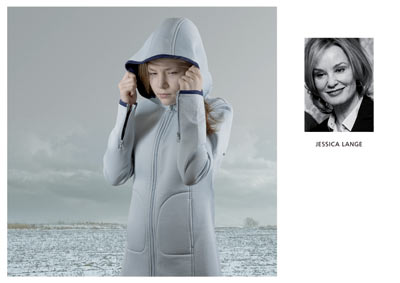 |
.jpg) |
Identity and typology are among the most frequented topics of current digitally manipulated photography. Since Nancy Burson joined together portraits of various dictators, movie actresses or American presidents which were not perfect in a technical sense, and then, out of their projection she would create a kind of averaged-out typological studies, digital technologies have rapidly advanced ahead. Today, digital technologies enable anthropologists as well as artists to create pictures of “typical” French women comprised of thousands of different portraits, and thanks to the technologies Yasamusa Morimura can make himself a part of paintings by old and new masters, while Tereza Vlèková is able to create phantom-like portraits of doublets of girls who might be either real twins or clones.
It is the motifs of clones and genetic relations that interest Barbora and Radim Žùrek very much. Their series Descendants with which the couple first attracted attention during their studies at the Institute of Creative Photography, Silesian University, Opava, already showed fictive children whose mother was Barbora, changing her likeness in a chameleon like way, and whose fathers were different men, including her own husband. At first sight, the comparative triplets of portraits seem to be only an entertaining game during which typical features of alleged parents join together in faces of non-existent adolescent children who have been formed in a computer. However, it not a mere play with genes for us to be entertained by comparing appearance of generated young males and females with the likeness of their alleged mothers and fathers. The artists deliberately disrupt the game when they show children in their early twenties which doesn’t correspond with the age of the alleged parents who are sometimes only a few years older than the children. Barbora Žùrková, who represents the mother in the triplets and whose features can be found in all the descendants, is only twenty years old (the Žùreks themselves are curious how much their real little daughter will take after the teenager who they have created digitally). The artists work with more profound intention as they explain: “With the help of computer assemblage we have tried to look for a broader picture of who we are, what we are about, who we used to be and who we could become.” The Žùreks bring a new dimension to their project by putting up these portraits of non-existent people on different web sites that post personals ads.
The couple’s latest series called The Replacement also bears more profound sociological and psychological undertone. So far, it is undoubtedly the highlight of their career which includes other works (e.g. a series of expressive portraits of blind people called The Blind that was awarded at the photography contest Czech Press Photo). In empty landscapes with low horizon where the sky is cloudy, Barbora and Radim Žùrek portray girls and boys at the threshold of adolescence whose faces (that are appropriately adjusted in a computer) remind us of child likeness or clones of many celebrities, universally known from TV screens or newspapers and magazines – actors, Harrison Ford, Al Pacino or Christopher Walken, actresses, Penélope Cruz, Joan Collins and Jessica Lange, a supermodel, Claudia Schiffer, footballers, Pelé and Pavel Nedvìd, a singer, Björk, the “pop king” Michael Jackson, a tennis player Boris Becker and even Wolfgang Amadeus Mozart. First of all, the viewer’s eye is drawn to the perfect technical and artistic execution of idyllic portraits of girls and boys on the brink between childhood and adolescence, between innocence and yet suppressed erotic desire. In spite of the presence of fine clothing, fine hairdos and the digitally accentuated likeness of these girls and boys to truly resemble the self-assured famous and rich, uncertainty, confusion and melancholy emanate from those angel-like and beautiful faces. Sad landscapes where there is no sun and dull colors augment the particular atmosphere. Thus, the Žùreks point out tension which exists between the original persona and his or her clone. We cannot be sure whether these are celebrities’ child portraits or their clones or adolescents who try their best to look like their idols (think about how many could be seen during the media craziness after Michael Jackson’s death). We are left uncertain, yet the artists encourage us to think about more general psychological issues as they state: “The confrontation of a clone and its original’s co-existence versus a child and a mother‘s (father‘s) co-existence opens up an issue regarding a degree of maturity in a man to accept himself as his own replacement, to accept his own clone in his personal environment of relationships he has been building for a long time, and, to possibly face desire to maintain private identity and uniqueness.”
Both the Žùrek’s series have drawn attention at a number of exhibitions in the Czech Republic as well as abroad, for example, at a photography biennale in Lyon, France, at the Festival of Art Photography in Warsaw, or at a Budapest’s Spring Festival. Their series The Replacement was chosen for a prestigious touring exhibition of the most talented young contemporary photographers called Generation 2: Tomorrow’s Photographers Today held by the Museum ¾Elysée in Lausanne, Switzerland, and their work is presented in a book bearing the same title, released by a famous publishing house Thames and Hudson. Barbora and Radim Žùrek have appeared on the Czech photographic scene like a comet would in the sky, however, their work possesses all significance to make sure they will stay there and they won’t disappear.
Vladimír Birgus
13/11/2009
A Perfect Day, Elise...
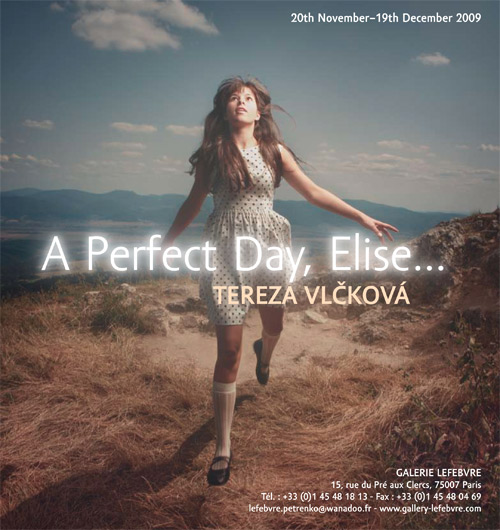
20th November –19th December 2009
A Perfect Day, Elise...
GALERIE LEFEBVRE
15, rue du Pré aux Clercs, 75007 Paris
Tél. : +33 (0)1 45 48 18 13 - Fax : +33 (0)1 45 48 04 69
lefebvre.petrenko@wanadoo.fr - www.gallery-lefebvre.com
Opening Reception
THE GALERIE LEFEBVRE
is pleased to announce:
A Perfect Day, Elise...
TEREZA VLČKOVÁ
Thursday, 19th November 2009, 6–9 pm
15, rue du Pré aux Clercs, 75007 PARIS
13/11/2009
CZECH AVANT-GARDE PHOTOGRAPHY"in Washington, D.C."
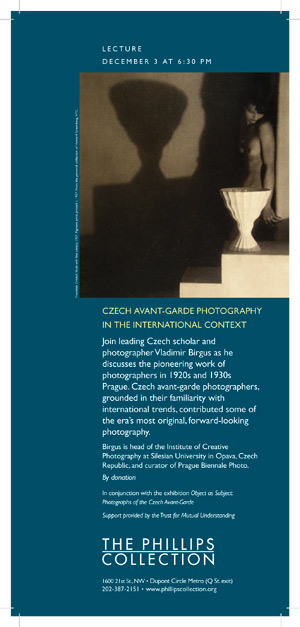 LECTURE
LECTURE
DECEMBER 3 AT 6:30 PM
CZECH AVANT-GARDE PHOTOGRAPHY IN THE INTERNATIONAL CONTEXT
Join leading Czech scholar and photographer Vladimir Birgus as he discusses the pioneering work of photographers in 1920s and 1930s Prague. Czech avant-garde photographers, grounded in their familiarity with international trends, contributed some of the era’s most original, forward-looking photography.
Birgus is head of the Institute of Creative Photography at Silesian University in Opava, Czech Republic, and curator of Prague Biennale Photo.
By donation
In conjunction with the exhibition Object as Subject: Photographs of the Czech Avant-Garde
Support provided by the Trust for Mutual Understanding
František Drtikol. Nude with Vase (detai), 1927. Pigment print, printed c. 1927. From the personal collection of Howard Greenberg, NYC

